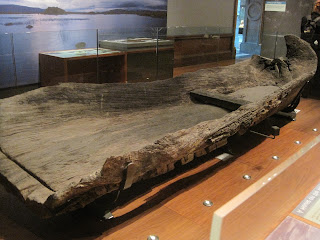This logboat was discovered in 1960 near the shore of Loch Glashan in Argyll, Scotland, and the boat led to the discovery in the lake of a nearby crannog -- an artificial island settlement. (This one was from the 6-8th centuries.) The boat is on display at the Kelvingrove Art Gallery and Museum in Glasgow.
The boat hasn't been well dated, and it's thought to date from the 1st through 10th centuries. A paddle found nearby -- which might or might not have been associated with the boat, has been dated to the 6th to 9th century.
The boat measures about 3.15 meters long and a bit under 0.8 meters in breadth. It possesses some interesting features for such a basic vessel.
The boat hasn't been well dated, and it's thought to date from the 1st through 10th centuries. A paddle found nearby -- which might or might not have been associated with the boat, has been dated to the 6th to 9th century.
The boat measures about 3.15 meters long and a bit under 0.8 meters in breadth. It possesses some interesting features for such a basic vessel.
 |
| A sitting thwart is supported on cleats left standing proud when the hull was hollowed out. It's quite low to keep the center of balance low. |
# # #
Photos by the blogger, except the final one, which is sourced with a link. The illustration is from the Kelvingrove Museum.



0 Response to "An Ancient Scottish Logboat"
Post a Comment